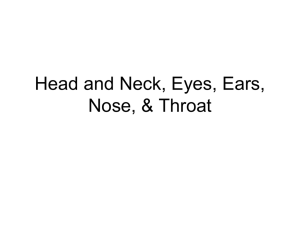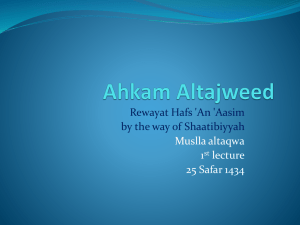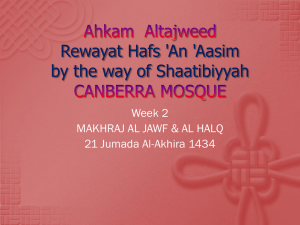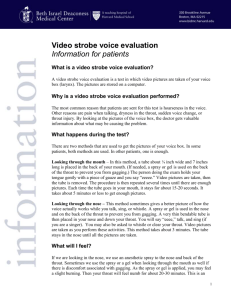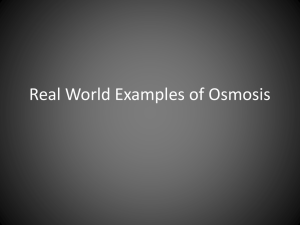Tajweed course foundation Lesson 4 throat jawf
advertisement
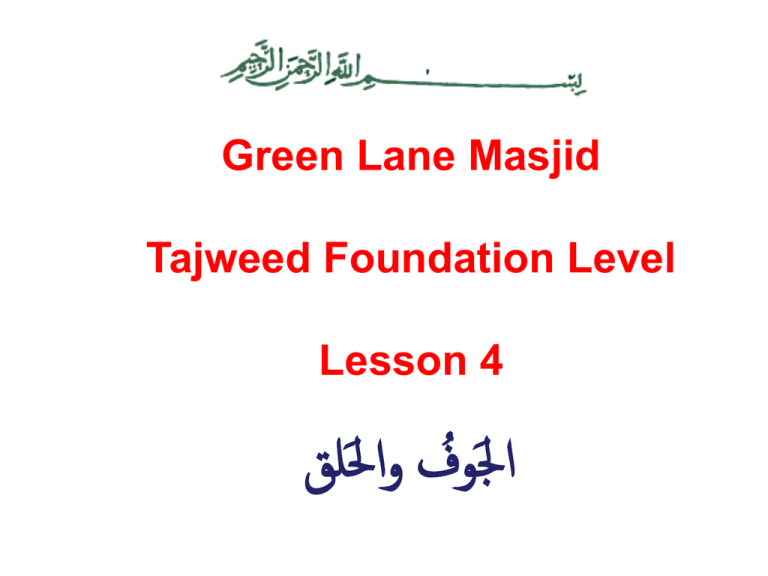
Green Lane Masjid Tajweed Foundation Level Lesson 4 اجل َُوف والَلق Recap of lesson 3 1)Put ( √ ) or ( X ) in front of the following sentences, correcting those sentences that are wrong: a) The Gunnah has only one mekhrej which is the empty space of the mouth and throat. X Gunnah from khaishoom a) The 3 medd letters are pronounced from the shifataan. X Medd letters from al-jouf a) All the 28 Arabic letters are pronounced from the Al-Halq, Ash-Shifataan and Al-Lisan. d) Al-Halq has 3 specific makharij while Al-Lisan has 10 specific makharij. e) Most of the Arabic letters are pronounced from AlLisan. f) In the Arabic language there are 17 specific makharij, 3 of them are in Al Halq. g) The 5 main malharij are: Al-Halq, Al-Khaishoom, AlLisan, Al-Ghunnah, Al-Jouf. X Not Ghunnah but Ash-Shifataan 2) Match the Arabic to the English: The Lips The Tongue The Empty space َ ُالجوف َ الخيشوم The Nose َّ َ ّ الشفتان َ ُالحلق The throat ّ َ اللسان ِّ of mouth and throat 3) What is the difference between a specific makhrij and a main mekhrij? A main makhrij has at least one specific or approximate makhrij whereas a specific makhraij will have at least one letter articulated from it. َ َ ُ ُ ُ ِ ِ مخ ِارج الحرو ف (Articulation points of the letters) Main مخ َرج َ The Throat The Tongue The Two lips The Nose Empty space in the mouth & throat No. Of Specific َ ُالحلق ُ ّ َ ُسان ُ الل ُِّ َ َّ ُالش ُفتان َ ُالخيشُوم ُ َ ُالجوف ُ No. of letters َمخ َرج 3 6 10 18 2 4 1 َُّالغنة 1 3 مدود ُ َ ِ الج وف Empty Space of mouth and throat َ Use ُالجوف ُ only to say the 3 medd letters in 1 َ َ approximate مخرج: No other part of the mouth is Used to lengthen a sound. ُ َو ََ ِـا What are the 3 medd letters? ِي ُلق َ ِ الح َ َ أدنى الحلق The closest part of throat غ خ ع ح أ هـ ُ َ َ َ وسط الحلق The middle part of throat َ َ أقص ى الحلق The furthest part of throat اإلس ِتعالء The characteristic of Istia’la The letters غand خhave the characteristic of istia’la. Istia’la means: the elevation (raising) of the back of the tongue to the upper palate upon pronouncing the islia’la letters, which are: خص ضغط قظ اإلس ِتعالء The sound flows out of the mouth Trapping the sound between the Roof of the mouth and the tongue لقُ َ الح ِ 1)Put ( √ ) or ( X ) in front of the following sentences, correcting those sentences that are wrong: a) Al-Halq is a main makhrij with 6 specific makhaarij for 3 letters. X 3 specific makhaarij for 6 letters. ) ءand ( ) هـare pronounced from the furthest part of the halq while ( ) حand ( )ع are pronounced from the closest and ( ) غand ( ) خare pronounced from the middle. X ع ح from middle and غ خfrom closest b) The letters ( c) Al-Jouf has 1 specific makhrij. X 1 approximate c) Al-Halq is one of 5 main makharij. X 3 specific d) Al-Jouf has 3 specific makharij for 1 letter. X 1 approximate makharij for 3 letters e) The letter of the halq are in the following order starting from the furthest part of al-halq: ( ) خ ( ) غ ( )ع ( ) ح ( ) هـ ( ) ء X عthen ح ََي ُو َـا. X ِي d) The 3 mudood letters are e) Al-Halq is divided into 3 specific makharrij called َ َ َ َ َ َ َ أدنى الح ِّلق وس ِّط الح ِّلق وأقص ى الحلق 2) a) What are the 3 mudood and what are the conditions for them to exist? َي ُو َـا b) Where are the 3 mudood articulated? الجوف 3) a) How many specific makhaarij does Al-Halq have? 3 b) Name the specific makharij with their english meaning. c) What are the six letters that are articulated from the specific makharij of al-halq?

